12 Lbs of Beef Tenderloin Protein
The best loftier-protein meat, seafood & eggs
- Protein percentage
- Video
- Poultry
- Red meat
- Deli & prepared meats
- Seafood
- Eggs
Meat, poultry, fish, shellfish, and eggs are loftier-protein foods that can help you lose weight. However, some types are better than others. The key? Maximizing satiety (feeling full and satisfied) per calorie when making food choices.
In this guide, we'll show you how different types of meat, seafood, and eggs rate on the poly peptide scale — and which ones to cull most often considering they help you feel total and provide maximum diet value. Plus, we'll share piece of cake, tasty recipes based on these foods.
The prototype below shows the protein as a percent of calories for dissimilar types of meat, seafood, and eggs.The higher the number, the more than protein the nutrient provides per calorie.
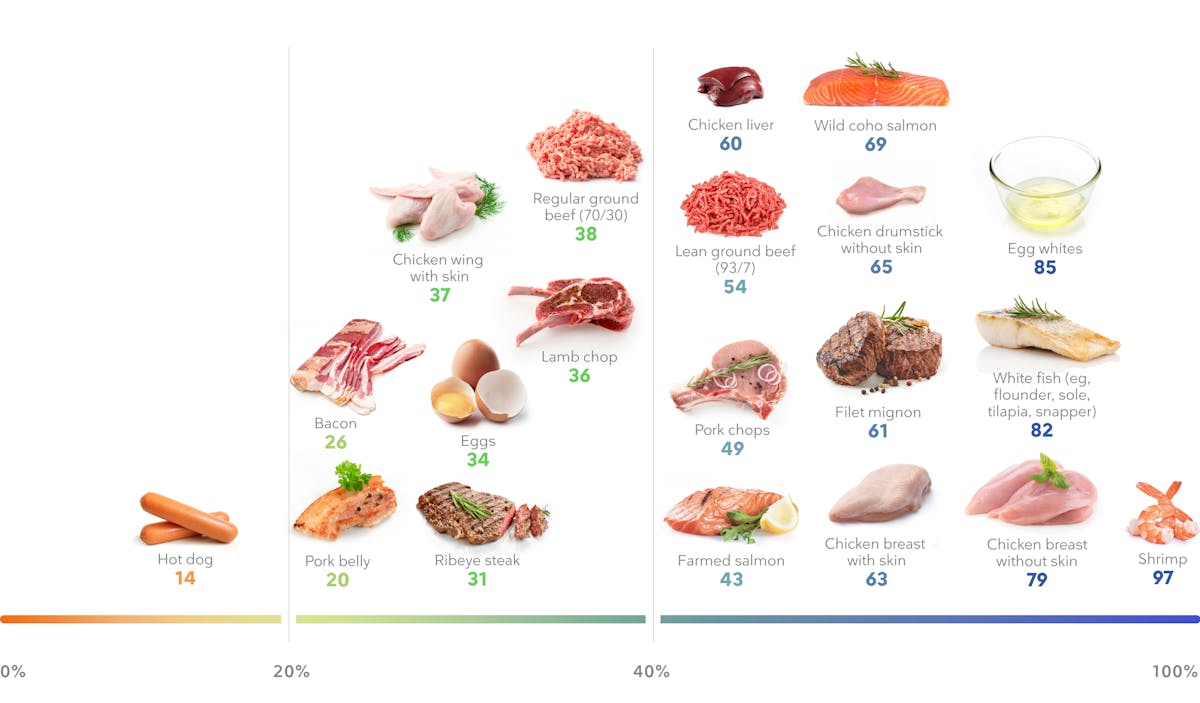
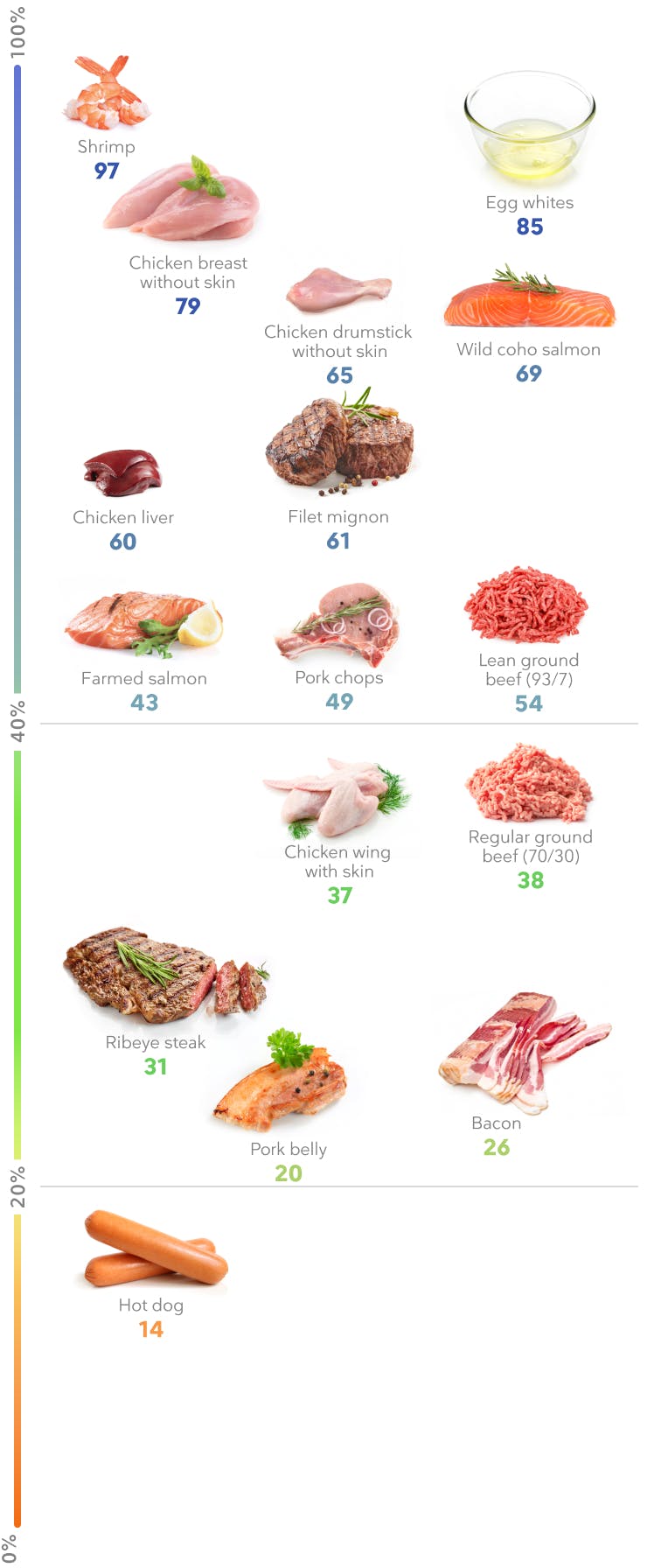
Key takeaways Aim for a high protein per centum. To lose weight, consume protein-rich foods. Most of the time, try to choose meat and seafood with at least 35% of calories from poly peptide. Learn more All-time cherry-red meat and poultry. Eat fresh meats like tenderloin, sirloin, lean footing meat, chicken, and turkey frequently. Eat processed meat less oftentimes. Learn more Best fish and shellfish. Eat all types of fish, including salmon, trout, halibut, snapper, tuna, etc. Bask shrimp, crab, lobster, and most other shellfish, also. Larn more
More high-protein guides
More high-protein guides
Or spotter a summary of this guide in video:
Focus on protein percentage
Stiff evidence shows that eating more protein, and less fats and carbs, tin can help y'all lose weight by reducing appetite and keeping your metabolism from slowing down.1
To lose weight without feeling hungry, select poly peptide-rich foods that provide the greatest satiety for the fewest calories.
How can you practise this? By choosing foods with a high "protein percentage." This per centum tells you how much of a food's calories come from protein as opposed to fats and carbs.
We believe selecting meat and seafood with protein percentages of 35% or more than most of the fourth dimension tin can be very helpful for good for you weight loss. More often than not speaking, leaner cuts of meat accept college protein percentages than fatty cuts practice.
Additionally, aim to consume at least 100 grams of protein per day if you're a adult female and 140 grams if you're a man of boilerplate superlative and build. Consume more if y'all're a human being taller than vi feet (183 cm) or a woman taller than v'6″ (168 cm) or if yous're very physically active. Eat less if you're shorter or have a petite frame.
All the same, don't feel that you need to meet all of your protein needs exclusively from the foods on this list. Dairy products, legumes, and vegetables can all contribute to your daily protein intake.
In this guide, we provide both the protein percentages and gram amounts per serving for meat, seafood, and eggs.2 These are based on average values. The protein percentages and gram amounts can vary depending on the cut of meat, the animal'south diet, the cooking method, and how much fat is trimmed before eating.
Note: The protein gram amounts are for cooked portions. Meat and seafood lose about 25% of their weight in cooking. The protein content of 4.5 ounces of raw meat or seafood is equivalent to about 3.five ounces of cooked meat or seafood.
1. Poultry
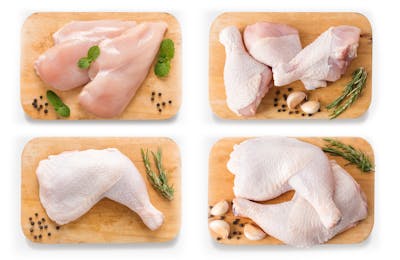 Chicken and turkey are high-satiety, protein foods that are great for weight loss. Indeed, all types of poultry accept fantabulous protein percentages! However, bacteria cuts (low-cal meat) by and large provide the about protein per calorie.
Chicken and turkey are high-satiety, protein foods that are great for weight loss. Indeed, all types of poultry accept fantabulous protein percentages! However, bacteria cuts (low-cal meat) by and large provide the about protein per calorie.
You'll also get a dainty dose of vitamins and minerals with that protein whether you lot choose light or dark meat.
The protein gram amounts reflect only the edible portion, not the bone. So whether you choose bone-in or boneless chicken breast or thighs, you'll all the same become the same amount of poly peptide.
Can you eat chicken with the skin and still lose weight? Aye. A piece of chicken with skin has a scrap more fat and therefore a slightly lower protein percentage than the same piece without skin. Yet, you'll even so get about the aforementioned grams of protein per serving.iii
Below are the poly peptide percentages and grams of protein per 3.five-ounce (100-gram) serving of cooked poultry (near the size of a deck of cards).
Craven
- Chicken breast without pare:
Protein percentage: 79%
30 to 32 grams of protein per serving (approximately one-half of a large chicken breast) - Chicken drumstick without pare:
Protein pct: 65%
26 to 28 grams of protein per serving (approximately two medium drumsticks) - Chicken chest with skin:
Poly peptide pct: 63%
thirty to 32 grams of protein per serving (approximately half of a large chicken breast) - Chicken liver:
Protein percentage: 60%
25 to 27 grams of protein and one gram of carbs per serving (limit liver to 1 serving per week due to its high vitamin A content) - Chicken wing without pare:
Poly peptide percentage: 60%
30 to 32 grams of protein per serving (approximately five wings) - Chicken thigh without peel:
Protein percentage: 55%
24 to 26 grams of protein per serving (approximately 1 medium chicken thigh) - Chicken drumstick with skin:
Protein percentage: 52%
26 to 28 grams of protein per serving (approximately two medium drumsticks) - Footing chicken:
Protein per centum: 49%
22 to 24 grams of poly peptide per serving - Chicken thigh with peel:
Poly peptide pct: 43%
24 to 26 grams of protein per serving (approximately one medium chicken thigh) - Chicken wing with skin:
Protein percentage: 37%
22 to 24 grams of protein per serving (approximately 3 wings)
Turkey
- Turkey breast without skin:
Poly peptide percentage: 85%
thirty to 32 grams of poly peptide per serving - Turkey drumstick without peel:
Poly peptide percentage: 67%
28 to 30 grams of protein per serving - Turkey breast with skin:
Poly peptide percentage: 66%
thirty to 32 grams of protein per serving - Turkey drumstick with skin:
Protein percentage: 57%
28 to 30 grams of protein per serving - Basis turkey (lean):
Poly peptide per centum: 50%
25 to 27 grams of protein per serving - Basis turkey (regular):
Protein percent: 42%
25 to 27 grams of protein per serving
High-protein poultry recipes
two. Red meat
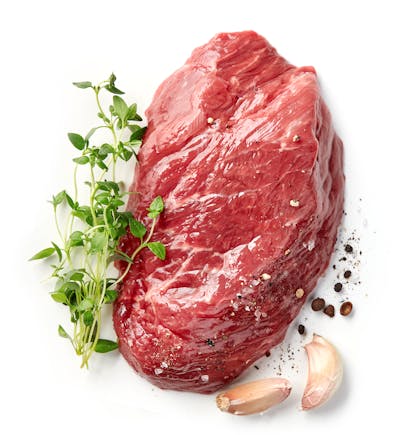 Red meat is an splendid protein-rich nutrient that provides several vitamins and minerals, including iron, potassium, and zinc. But not all types are equal when it comes to poly peptide. Fatty meats provide less protein per calorie than lean types and therefore have lower poly peptide percentages.
Red meat is an splendid protein-rich nutrient that provides several vitamins and minerals, including iron, potassium, and zinc. But not all types are equal when it comes to poly peptide. Fatty meats provide less protein per calorie than lean types and therefore have lower poly peptide percentages.
For instance, 3.5 ounces (100 grams) of lean beefiness steak contains little fat, so its poly peptide pct is very loftier at 70%. By comparison, iii.5 ounces of beefiness brisket has most the same grams of protein as 3.five ounces of lean steak, but more fat (and calories).
Beef brisket'due south protein percentage is 40% because information technology provides much less poly peptide per calorie than lean steak.
Choosing meats with protein percentages above 35% may help you lose weight most finer. Still, nutrient enjoyment and diverseness are important, too! So feel costless to eat your favorite meats that have lower poly peptide percentages sometimes.
Hither are the poly peptide percentages and grams of protein per 3.v-ounce (100-gram) serving of cooked red meat (nigh the size of a deck of cards).
Beef
- Eye of round steak:
Poly peptide percentage: 70%
28 to 30 grams of protein per serving - Elevation sirloin steak:
Protein percentage: 69%
28 to 30 grams of poly peptide per serving - Liver:
Protein percentage: 62%
27 to 29 grams of protein and 4 grams of carbs per serving (limit liver to ane serving per calendar week due to its high vitamin A content) - Filet mignon (beef tenderloin):
Protein percentage: 61%
28 to 30 grams of protein per serving - Ground beef, lean (93% lean/seven% fat):
Poly peptide percentage: 54%
25 to 27 grams of protein per serving
- Ground beef, regular (85/15):
Protein percentage: 42%
24 to 26 grams of protein per serving - Brisket:
Protein percent: forty%
27 to 29 grams of poly peptide per serving - Ground beef, regular (70/xxx):
Protein per centum: 38%
24 to 26 grams of protein per serving - Ribeye steak:
Poly peptide percent: 31%
20 to 24 grams of protein per serving - Prime number rib:
Protein percent: xxx%
20 to 24 grams of protein per serving
Basis beef classifications similar extra-lean, lean, etc., are defined by laws set by the USDA. They are based on the per centum of lean and fat a meat contains by weight (which includes water) rather than the percentage of protein and fatty that contribute to calories. You will often meet 93/7 (lean), 85/xv, and similar numbers on meat packages. Don't let those values confuse you! Just focus on the protein percentages for different ground meats in this guide.What exercise these fractions hateful?
Pork
- Pork tenderloin:
Protein percentage: 71%
26 to 28 grams of protein per serving - Basis pork, extra-lean (94% lean/6% fatty):
Protein pct: 64%
28 to 30 grams of protein per serving - Pork chops:
Poly peptide per centum: 49%
26 to 28 grams of protein per serving - Pork roast:
Protein percentage: 47%
26 to 28 grams of poly peptide per serving - Ground pork, regular (85/15):
Protein percentage: 36%
26 to 28 grams of protein per serving - Pork shoulder:
Protein pct: 34%
22 to 24 grams of protein per serving - Ground pork, regular (72/28):
Protein per centum: 25%
22 to 24 grams of poly peptide per serving - Pork ribs:
Protein pct: 23%
19 to 22 grams of protein per serving (three medium ribs) - Pork belly:
Protein percent: 20%
15 to 18 grams of protein per serving
Lamb
- Lamb tenderloin:
Protein percent: 67%
30 to 32 grams of poly peptide per serving - Leg of lamb:
Poly peptide percentage: 50%
26 to 28 grams of protein per serving - Lamb shank:
Poly peptide percentage: 47%
28 to xxx grams of protein per serving - Lamb chops or rack of lamb:
Protein percentage: 36%
27 to 29 grams of protein per serving (approximately two to iii lamb chops) - Ground lamb:
Poly peptide percentage: 36%
24 to 26 grams of protein per serving
Bison
- Meridian round or ribeye steak:
Protein percent: seventy%
29 to 31 grams of protein per serving - Ground bison:
Protein percentage: 59%
25 to 27 grams of protein per serving
Veal
- Sirloin:
Protein percentage: 59%
25 to 27 grams of protein per serving - Ground veal:
Protein percentage: 56%
23 to 25 grams of poly peptide per serving - Rib:
Protein percentage: 42%
23 to 25 grams of poly peptide per serving
Loftier-poly peptide red meat recipes
three. Deli and prepared meats
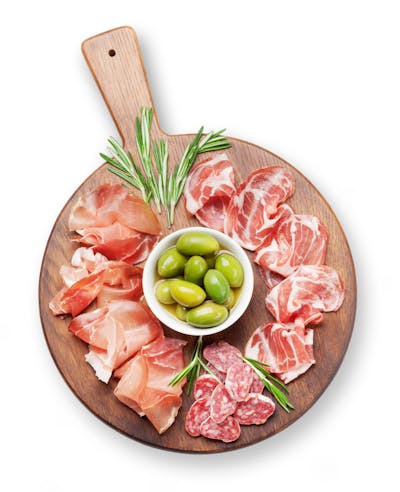 Processed meats — meats that accept been cured, smoked, or dried — are often considered less good for you than their fresh counterparts.
Processed meats — meats that accept been cured, smoked, or dried — are often considered less good for you than their fresh counterparts.
Although claims that they may lead to health problems are based on very weak observational evidence, processed meats mostly contain less poly peptide than fresh meat.4Therefore, near of them are non ideal for losing weight.
The good news is, some processed meats do take loftier protein percentages. Savour these regularly, and save some of the other types for when you desire to occasionally indulge.
Here are the poly peptide percentages and grams of protein per 3.five-ounce (100-gram) serving of deli and prepared meats (nigh the size of a deck of cards, unless otherwise noted).5
- Canadian salary (extra-lean ham):
Protein per centum: 77%
27 to 29 grams of protein per serving - Lean turkey, chicken, roast beef, or ham cafeteria meat:
Protein percentage: 60 to 80% (Extra-lean meat without added sugar or fillers may have protein percentages as loftier equally 80%)
15 to twenty grams of protein per serving - Pastrami:
Poly peptide percentage: 60%
xx to 24 grams of protein per serving (Read the label to find the number of slices per serving) - Prosciutto:
Protein pct: 54%
20 to 24 grams of protein per serving (Read the label to observe the number of slices per serving) - Chicken or turkey sausage:
Poly peptide percentage: 46%
18 to 20 grams of protein per serving (approximately iv to six medium links) - Turkey salary:
Protein pct: 45%
38 to 42 grams of poly peptide per 3.5 ounces /100 grams (approximately 8 slices)
19 to 21 grams of protein per serving (approximately four slices) - Corned beef:
Protein percentage: 43%
25 to 28 grams of protein per serving - Salary:
Protein percentage: 26%
33 to 37 grams of protein per 3.5 ounces/100 grams (approximately 12 slices)
11 to 12 grams of protein per serving (approximately four slices) - Pork sausage:
Protein percent: 22%
15 to 18 grams of poly peptide (approximately four to six medium links) - Salami:
Poly peptide pct: 22%
eighteen to 22 grams of protein per iii.v ounces/100 grams (approximately 10 medium slices)
9 to 11 grams of protein per serving (approximately five slices) - Liverwurst:
Protein pct: 17%
14 to 16 grams of protein (approximately one-half cup) - Hot dog:
Protein percentage: 14%
ten to 12 grams of protein (approximately two medium-sized hot dogs)
iv. Seafood
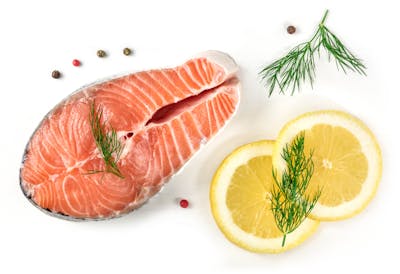 Seafood has a well-deserved reputation for being 1 of the best weight loss foods. Because fish and shellfish are high in protein all the same depression in fatty and carbs, near all types have impressive poly peptide percentages.
Seafood has a well-deserved reputation for being 1 of the best weight loss foods. Because fish and shellfish are high in protein all the same depression in fatty and carbs, near all types have impressive poly peptide percentages.
Make seafood choices based on your preferences and what is available. Canned fish and shellfish are convenient, less expensive options.
Enjoy seafood several times a week, if you like. However, avoid or limit types of fish that are high in mercury, particularly larger fish similar bigeye tuna, Rex mackerel, swordfish, and shark.
Fish
Besides packing plenty of protein, fish are rich in vitamin B2 (riboflavin), potassium, and selenium, among other nutrients. While fat fish like salmon and sardines have slightly lower protein percentages than lean fish, they provide higher amounts of essential omega-three fat acids.
Here are the protein percentages and grams of protein per three.five-ounce (100-gram) serving of cooked fish (about the size of a deck of cards), unless otherwise noted.
- White fish (such as flounder, sole, halibut, pollack, snapper, and tilapia):
Protein percentage: 82%
23 to 27 grams of protein per serving - Sea bass:
Protein percentage: 77%
24 to 26 grams of protein per serving - Canned tuna (light or albacore):
Poly peptide percentage: 75%
23 to 25 grams of protein per serving (Limit to once a calendar week due to its high mercury content) - Canned pink salmon*:
Protein percentage: 73%
24 to 26 grams of protein per serving - Wild salmon (Coho):
Protein pct: 69%
23 to 25 grams of poly peptide per serving - Raw tuna (sashimi):
Protein percent: 64%
22 to 24 grams of poly peptide per serving (Limit tuna to once a week due to its high mercury content) - Anchovies:
Poly peptide percent: 62%
24 to 26 grams of protein per serving - Trout:
Protein percentage: 57%
26 to 28 grams of poly peptide per serving - Raw salmon (Atlantic):
Poly peptide percentage: 56%
19 to 21 grams of poly peptide per serving - Farmed salmon (Coho):
Protein percentage: 54%
23 to 25 grams of protein per serving - Herring:
Protein percentage: 46%
23 to 25 grams of poly peptide per serving - Sardines:
Protein per centum: 45%
23 to 25 grams of poly peptide per serving - Farmed salmon (Atlantic):
Protein percentage: 43%
21 to 23 grams of poly peptide per serving - Mackerel:
Protein pct: 38%
23 to 25 grams of protein per serving
*Annotation: Different species of salmon have dissimilar fat contents and therefore higher or lower poly peptide percentages.
Shellfish
All shellfish are high in protein and low in fat. Yet, some incorporate a few carbs, which lowers their protein percentage. Shellfish are too a great source of vitamin B12, magnesium, and iodine.
Hither are the poly peptide percentages and grams of protein per 3.five-ounce (100-gram) serving of cooked shellfish, unless otherwise noted.
- Shrimp and prawns:
Protein per centum: 97%
23 to 25 grams of protein per serving (10 to 12 medium shrimp or prawns) - Crab:
Protein pct: 87%
eighteen to 20 grams of protein per serving (approximately one average crab leg or 1 cup of cooked crab) - Lobster:
Protein percentage: 85%
20 to 22 grams of poly peptide per serving (approximately one small-scale lobster tail or two-thirds of a loving cup of cooked lobster) - Scallops:
Protein percentage: 76%
xviii to 20 grams of protein and 4 to 5 grams of carbs per serving (half dozen large sea scallops) - Octopus:
Protein per centum: 73%
26 to 28 grams of protein and iv to five grams of carbs per serving (approximately half cup) - Clams:
Protein percentage: lxx%
24 to 26 grams of protein and five grams of carbs per serving (approximately 10 pocket-sized clams) - Squid:
Protein percent: 69%
17 to xix grams of protein and 3 grams of carbs per serving (approximately i-half cup) - Mussels:
Protein percentage: 56%
24 grams of protein and seven grams of carbs per serving (approximately 20 to 25 medium mussels) - Oysters (raw):
Protein percentage: 49%
v to x grams of protein and 5 to 6 grams carbs per serving (approximately four to viii medium oysters, depending on the type) 6 - Oysters (cooked):
Protein percent: 47%
12 to 19 grams of protein and half dozen to 8 grams of carbs per serving (approximately 10 to 12 medium oysters, depending on the type) 7
High-protein fish and shellfish recipes
5. Eggs
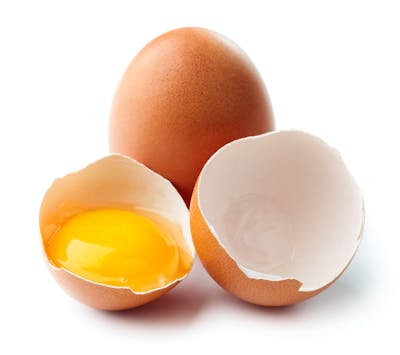 Eggs are versatile, loftier in poly peptide, and weight loss-friendly.
Eggs are versatile, loftier in poly peptide, and weight loss-friendly.
Egg whites provide more poly peptide per calorie than egg yolks. All the same, the yolks incorporate more essential nutrients, such as vitamin A and selenium, than egg whites. Whole eggs are more nutritious overall and gustatory modality better than egg whites.
Nosotros recommend that you mainly eat whole eggs, only feel gratuitous to as well include some egg whites if yous find it hard to run into your poly peptide targets.
Here are the poly peptide percentages and grams of protein per iii.5-ounce (100-gram) serving of eggs:
- Egg whites:
Protein percentage: 85%
11 grams of protein per serving (3 large egg whites) - Whole eggs:
Protein percentage: 34%
12 grams of protein per serving (two large eggs) - Egg yolks:
Protein percent: 20%
16 grams of protein per serving (six large egg yolks)
High-protein egg recipes



Learn more about protein
The all-time high-protein meat, seafood & eggs - the evidence
This guide is written by Franziska Spritzler, RD and was last updated on June 3, 2022. It was medically reviewed by Dr. Bret Scher, Physician on May 14, 2021.
The guide contains scientific references. Y'all can find these in the notes throughout the text, and click the links to read the peer-reviewed scientific papers. When advisable we include a grading of the force of the evidence, with a link to our policy on this. Our bear witness-based guides are updated at to the lowest degree once per twelvemonth to reverberate and reference the latest science on the topic.
All our evidence-based health guides are written or reviewed by medical doctors who are experts on the topic. To stay unbiased we show no ads, sell no concrete products, and have no money from the industry. Nosotros're fully funded by the people, via an optional membership. Most information at Diet Doc is complimentary forever.
Read more than about our policies and work with evidence-based guides, nutritional controversies, our editorial team, and our medical review board.
Should you find whatever inaccuracy in this guide, please email andreas@dietdoctor.com.
Source: https://www.dietdoctor.com/high-protein/meat-seafood-eggs





0 Response to "12 Lbs of Beef Tenderloin Protein"
Postar um comentário